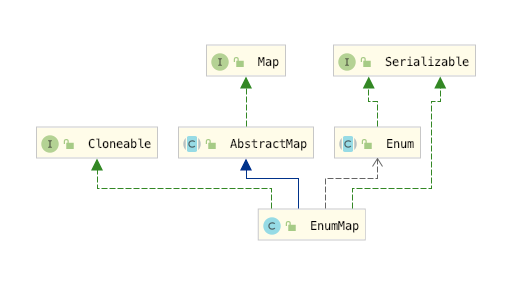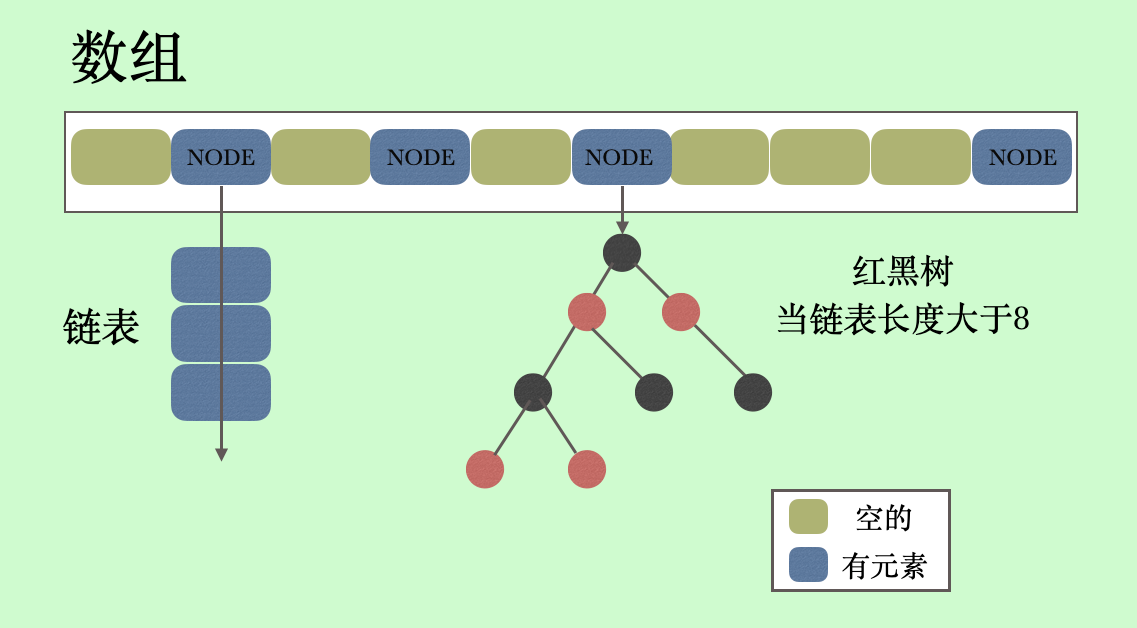EnumMap
前面我们学习了枚举,主要讲解了枚举的实现原理和主要使用场景,这一节我们学习一个和枚举相关的集合——EnumMap,EnumMap 是Java 集合框架提供的一个每个元素都是枚举类型的Map 集合,在EnumMap中枚举元素被用作key。
一. EnumMap 的说明书
还是按照国际惯例,先看一下EnumMap 的说明书,其实往往很多时候你的困惑都在说明书里写着呢,但是在此之前我们还是先看一下它的继承关系,让我们有一个大概的认识

首先我们看到它是数据集合体系下的Map 家族,然后看到它除了继承了AbstractMap 抽象类,还实现了Serializable 和Cloneable 已经我们今天的重点Enum 接口
下面我们就看一下类的注释,来大致了解一下EnumMap。
/**
* A specialized {@link Map} implementation for use with enum type keys. All
* of the keys in an enum map must come from a single enum type that is
* specified, explicitly or implicitly, when the map is created. Enum maps
* are represented internally as arrays. This representation is extremely
* compact and efficient.
* 它是使用enum类型作为key的一种特殊的Map 实现类,不论是显式还是隐式的,所有的key都必须是来自同一个枚举类的枚举变量这就是特殊的所在之处
* Enum maps 底层是通过数组实现的,这个底层实现方式是极其经凑和高效的
* <p>Enum maps are maintained in the <i>natural order</i> of their keys
* (the order in which the enum constants are declared). This is reflected
* in the iterators returned by the collections views ({@link #keySet()},
* {@link #entrySet()}, and {@link #values()}).
* Enum maps 维持了自然key 的自然顺序,这个顺序就是枚举常量的声明顺序,这个特性也反应在了keySet,entrySet,values 方法返回的collection 集合中
* <p>Iterators returned by the collection views are <i>weakly consistent</i>:
* they will never throw {@link ConcurrentModificationException} and they may
* or may not show the effects of any modifications to the map that occur while
* the iteration is in progress.
* 需要注意的是Enum maps的迭代器返回的collection 视图是弱一致性的,也就是说在遍历的过程中如果发生了修改是不会抛出异常的,但是对于其他Map 的实现就会的
* <p>Null keys are not permitted. Attempts to insert a null key will
* throw {@link NullPointerException}. Attempts to test for the
* presence of a null key or to remove one will, however, function properly.
* Null values are permitted.
* Null keys 是不允许的。尝试插入或者检测是否存在甚至是删除都会抛出NullPointerException,但是这些在功能上是合理的。Null values 是允许的
* <P>Like most collection implementations <tt>EnumMap</tt> is not
* synchronized. If multiple threads access an enum map concurrently, and at
* least one of the threads modifies the map, it should be synchronized
* externally. This is typically accomplished by synchronizing on some
* object that naturally encapsulates the enum map. If no such object exists,
* the map should be "wrapped" using the {@link Collections#synchronizedMap}
* method. This is best done at creation time, to prevent accidental
* unsynchronized access:
* 和其他大多数集合一样EnumMap是线程不安全的. 所以如果有多个线程在访问并且不止一个线程在修改EnumMap,EnumMap应该在这些操作的外面通过在一个object 上面加锁来保证线程安全
* 如果没有这样的对象,你可以通过使用 Collections#synchronizedMap 方法,返回其对应的线程安全的封装类
* <p>Implementation note: All basic operations execute in constant time.
* They are likely (though not guaranteed) to be faster than their
* {@link HashMap} counterparts.
* 它比它的兄弟HashMap快一些,
* @author Josh Bloch
* @see EnumSet
* @since 1.5
*/
public class EnumMap<K extends Enum<K>, V> extends AbstractMap<K, V>
implements java.io.Serializable, Cloneable
{
//Class对象引用
private final Class<K> keyType;
//存储Key值的数组
private transient K[] keyUniverse;
//存储Value值的数组
private transient Object[] vals;
//map的size
private transient int size = 0;
//空map
private static final Enum<?>[] ZERO_LENGTH_ENUM_ARRAY = new Enum<?>[0];
//构造函数
public EnumMap(Class<K> keyType) {
this.keyType = keyType;
keyUniverse = getKeyUniverse(keyType);
vals = new Object[keyUniverse.length];
}
}
在学习EnumMap 之前,建议先学习枚举初识 和 枚举进阶
二. EnumMap的使用
创建一个 EnumMap
为了创建一个EnumMap,我们首先需要引入java.util.EnumMap类,一旦我们引入了就可以按照下面的方式创建EnumMap
enum Size {
SMALL, MEDIUM, LARGE, EXTRALARGE
}
EnumMap<Size, Integer> sizes = new EnumMap<>(Size.class);
上面我们创建了一个EnumMap,Size类型作为EnumMap的key 的类型,Integer 作为EnumMap的Value 的类型
EnumMap 插入
put()- 插入指定的key-value 对到EnumMapputAll()- 插入一个指定的map 的 key-value 对 EnumMap
For example,
@Test
public void insert(){
EnumMap<Size, Integer> sizes = new EnumMap<>(Size.class);
sizes.put(Size.SMALL, 28);
sizes.put(Size.MEDIUM, 32);
System.out.println("EnumMap1: " + sizes);
EnumMap<Size, Integer> sizes2 = new EnumMap<>(Size.class);
// Using the putAll() Method
sizes2.putAll(sizes);
sizes2.put(Size.LARGE, 36);
System.out.println("EnumMap2: " + sizes2);
}
Output
EnumMap1: {SMALL=28, MEDIUM=32}
EnumMap2: {SMALL=28, MEDIUM=32, LARGE=36}
获取 EnumMap 的元素
1. 使用 entrySet(), keySet() and values()
entrySet()- 返回一个set 集合包含EnumMap的元素keySet()- 返回一个set 集合包含EnumMap 中的keysvalues()- 返回一个set 集合包含EnumMap 中的values
@Test
public void access(){
// Creating an EnumMap of the Size enum
EnumMap<Size, Integer> sizes = new EnumMap<>(Size.class);
sizes.put(Size.SMALL, 28);
sizes.put(Size.MEDIUM, 32);
sizes.put(Size.LARGE, 36);
sizes.put(Size.EXTRALARGE, 40);
System.out.println("EnumMap: " + sizes);
// Using the entrySet() Method
System.out.println("Key/Value mappings: " + sizes.entrySet());
// Using the keySet() Method
System.out.println("Keys: " + sizes.keySet());
// Using the values() Method
System.out.println("Values: " + sizes.values());
}
Output
EnumMap: {SMALL=28, MEDIUM=32, LARGE=36, EXTRALARGE=40}
Key/Value mappings: [SMALL=28, MEDIUM=32, LARGE=36, EXTRALARGE=40]
Keys: [SMALL, MEDIUM, LARGE, EXTRALARGE]
Values: [28, 32, 36, 40]
这里也验证了我们在类注释中说的有序性
2. 使用 get() 方法
get() 方法会返回对应key 的值,如果找不到对应的key,则返回null
@Test
public void access(){
// Creating an EnumMap of the Size enum
EnumMap<Size, Integer> sizes = new EnumMap<>(Size.class);
sizes.put(Size.SMALL, 28);
sizes.put(Size.MEDIUM, 32);
sizes.put(Size.LARGE, 36);
sizes.put(Size.EXTRALARGE, 40);
System.out.println("EnumMap: " + sizes);
int value = sizes.get(Size.MEDIUM);
System.out.println("Value of MEDIUM: " + value);
}
Output
EnumMap: {SMALL=28, MEDIUM=32, LARGE=36, EXTRALARGE=40}
Value of MEDIUM: 32
删除 EnumMap 元素
remove(key)- 删除特定key 对应的key-value,并且返回valueremove(key, value)- 删除特定的key和value 都相等的key-value,并且返回true
@Test
public void remove(){
// Creating an EnumMap of the Size enum
EnumMap<Size, Integer> sizes = new EnumMap<>(Size.class);
sizes.put(Size.SMALL, 28);
sizes.put(Size.MEDIUM, 32);
sizes.put(Size.LARGE, 36);
sizes.put(Size.EXTRALARGE, 40);
System.out.println("EnumMap: " + sizes);
// Using the remove() Method
int value = sizes.remove(Size.MEDIUM);
System.out.println("Removed Value: " + value);
boolean result = sizes.remove(Size.SMALL, 28);
System.out.println("Is the entry {SMALL=28} removed? " + result);
System.out.println("Updated EnumMap: " + sizes);
}
Output
EnumMap: {SMALL=28, MEDIUM=32, LARGE=36, EXTRALARGE=40}
Removed Value: 32
Is the entry {SMALL=28} removed? True
Updated EnumMap: {LARGE=36, EXTRALARGE=40}
替换 EnumMap 的元素
replace(key, value)- 使用新值代替特定key 的旧值replace(key, old, new)- 使用新值代替特定key 的旧值,只有当提供的旧值和特定key 的旧值相等时猜替换replaceAll(function)-使用特定函数的返回值替代所有的value
@Test
public void replace(){
// Creating an EnumMap of the Size enum
EnumMap<Size, Integer> sizes = new EnumMap<>(Size.class);
sizes.put(Size.SMALL, 28);
sizes.put(Size.MEDIUM, 32);
sizes.put(Size.LARGE, 36);
sizes.put(Size.EXTRALARGE, 40);
System.out.println("EnumMap: " + sizes);
// Using the replace() Method
sizes.replace(Size.MEDIUM, 30);
sizes.replace(Size.LARGE, 36, 34);
System.out.println("EnumMap using replace(): " + sizes);
// Using the replaceAll() Method
sizes.replaceAll((key, oldValue) -> oldValue + 3);
System.out.println("EnumMap using replaceAll(): " + sizes);
}
Output
EnumMap: {SMALL=28, MEDIUM=32, LARGE=36, EXTRALARGE=40}
EnumMap using replace(): {SMALL=28, MEDIUM=30, LARGE=34, EXTRALARGE=40}
EnumMap using replaceAll(): {SMALL=31, MEDIUM=33, LARGE=37, EXTRALARGE=43}
需要注意的是函数的声明,这个函数遍历了整个EnumMap然后替换了所有的值
sizes.replaceAll((key, oldValue) -> oldValue + 3);
其他方法
| Method | Description |
|---|---|
clone() |
Creates a copy of the EnumMap |
containsKey() |
Searches the EnumMap for the specified key and returns a boolean result |
containsValue() |
Searches the EnumMap for the specified value and returns a boolean result |
size() |
Returns the size of the EnumMap |
clear() |
Removes all the entries from the EnumMap |
三. EnumSet 对比 EnumMap
EnumSet 和 EnumMap 都是存储enum 类型的数据结构,但是它们之间还是有下面的不同
- EnumSet和其他的Set 类型,例如HashSet 不一样,EnumSet不是依赖器对应的HashMap 的而是通过一些列的bits 实现的,EnumMap 和其他Map 一样例如HashMap ,底层依赖的都是数组,具体可以看深度剖析HashSet 和深度剖析HashMap
- EnumSet 使用的实静态方法
allOf(),noneOf(),of()创建的,而EnumMap 是通过构造方法创建的
三. EnumMap 的使用场景
其实学到了现在,我们都没有介绍EnumMap的使用场景
我们前面学Enum 的时候介绍了Enum主要用来管理常量的定义,主要用在一些状态变量的定义,而Map 主要用来记录一些key-value 对,例如日活的统计,那么EnumMap主要就是用来存储对一些常量的统计信息或者其他对应的信息。
先思考这样一个问题,现在我们有一堆size大小相同而颜色不同的数据,需要统计出每种颜色的数量是多少以便将数据录入仓库,定义如下枚举用于表示颜色Color:
enum Color {
GREEN,RED,BLUE,YELLOW
}
我们有如下解决方案,使用Map集合来统计,key值作为颜色名称,value代表衣服数量,如下:
public class EnumMapExample {
enum Color {
GREEN,RED,BLUE,YELLOW
}
@AllArgsConstructor
@Getter
private class Clothes {
String name;
Color color;
}
@Test
public void test() {
List<Clothes> list = new ArrayList<>();
list.add(new Clothes("C001",Color.BLUE));
list.add(new Clothes("C002",Color.YELLOW));
list.add(new Clothes("C003",Color.RED));
list.add(new Clothes("C004",Color.GREEN));
list.add(new Clothes("C005",Color.BLUE));
list.add(new Clothes("C006",Color.BLUE));
list.add(new Clothes("C007",Color.RED));
list.add(new Clothes("C008",Color.YELLOW));
list.add(new Clothes("C009",Color.YELLOW));
list.add(new Clothes("C010",Color.GREEN));
//方案1:使用HashMap
Map<String,Integer> map = new HashMap<>();
for (Clothes clothes:list){
String colorName=clothes.getColor().name();
Integer count = map.get(colorName);
if(count!=null){
map.put(colorName,count+1);
}else {
map.put(colorName,1);
}
}
System.out.println(map.toString());
System.out.println("---------------");
//方案2:使用EnumMap
Map<Color,Integer> enumMap=new EnumMap<>(Color.class);
for (Clothes clothes:list){
Color color=clothes.getColor();
Integer count = enumMap.get(color);
if(count!=null){
enumMap.put(color,count+1);
}else {
enumMap.put(color,1);
}
}
System.out.println(enumMap.toString());
}
}
输出
{RED=2, BLUE=3, YELLOW=3, GREEN=2}
---------------
{GREEN=2, RED=2, BLUE=3, YELLOW=3}
代码比较简单,我们使用两种解决方案,一种是HashMap,一种EnumMap,虽然都统计出了正确的结果,但是EnumMap作为枚举的专属的集合,我们没有理由再去使用HashMap,毕竟EnumMap要求其Key必须为Enum类型,因而使用Color枚举实例作为key是最恰当不过了,也避免了获取name的步骤,更重要的是EnumMap效率更高,因为其内部是通过数组实现的。
注 例子来源于网络
四. 源码与扩展
put /get 方法的源码
put 方法的返回值还是和HashMap 一样的,都是返回对应的value,但是插入的实现却是简单了很多,
public V put(K key, V value) {
//检测key的类型
typeCheck(key);
//获取存放value值的数组下标
int index = key.ordinal();
//获取旧值
Object oldValue = vals[index];
//设置新的value值
vals[index] = maskNull(value);
// 如果key 不存在也就是oldValue是null 则标记map大小的变量加1
if (oldValue == null)
size++;
return unmaskNull(oldValue);
}
这里通过typeCheck方法进行了key类型检测,判断是否为枚举类型,如果类型不对,会抛出异常
private void typeCheck(K key) {
Class<?> keyClass = key.getClass();//获取类型信息
if (keyClass != keyType && keyClass.getSuperclass() != keyType)
throw new ClassCastException(keyClass + " != " + keyType);
}12345
接着通过int index = key.ordinal()的方式获取到该枚举实例的顺序值,利用此值作为下标,把值存储在vals数组对应下标的元素中即vals[index],这也是为什么EnumMap能维持与枚举实例相同存储顺序的原因,我们发现在对vals[]中元素进行赋值和返回旧值时分别调用了maskNull方法和unmaskNull方法
get 方法的源码更简单
public V get(Object key) {
return (isValidKey(key) ?
unmaskNull(vals[((Enum<?>)key).ordinal()]) : null);
}
EnumMap 的有序性
@Test
public void order(){
// Creating an EnumMap of the Size enum
EnumMap<Size, Integer> sizes = new EnumMap<>(Size.class);
HashMap< Size, Integer> sizes2=new HashMap<>();
// 按照枚举变量的声明顺序插入
sizes.put(Size.SMALL, 28);
sizes.put(Size.MEDIUM, 32);
sizes.put(Size.LARGE, 36);
sizes.put(Size.EXTRALARGE, 40);
sizes2.put(Size.SMALL, 28);
sizes2.put(Size.MEDIUM, 32);
sizes2.put(Size.LARGE, 36);
sizes2.put(Size.EXTRALARGE, 40);
System.out.println("EnumMap: " + sizes);
System.out.println("HashMap: " + sizes2);
sizes.clear();
sizes2.clear();
// 随机插入
sizes.put(Size.LARGE, 36);
sizes.put(Size.EXTRALARGE, 40);
sizes.put(Size.SMALL, 28);
sizes.put(Size.MEDIUM, 32);
sizes2.put(Size.LARGE, 36);
sizes2.put(Size.EXTRALARGE, 40);
sizes2.put(Size.SMALL, 28);
sizes2.put(Size.MEDIUM, 32);
System.out.println("EnumMap: " + sizes);
System.out.println("HashMap: " + sizes2);
}
输出
EnumMap: {SMALL=28, MEDIUM=32, LARGE=36, EXTRALARGE=40}
HashMap: {SMALL=28, EXTRALARGE=40, LARGE=36, MEDIUM=32}
EnumMap: {SMALL=28, MEDIUM=32, LARGE=36, EXTRALARGE=40}
HashMap: {SMALL=28, EXTRALARGE=40, LARGE=36, MEDIUM=32}
我们看到不论是按照枚举变量的声明顺序插入,还是随机插入EnumMap 的输出顺序都是一样的,那就是按照枚举变量的声明顺序排序,但是HashMap就是无序的
没有 fail-fast
前面我们学习其他集合的时候,不止一次的提到了这个问题和演示了它,之所以fail-fast是处于一种设计理念,那就是宁愿失败也不要计算结果错误,但是EnumMap却没有保证这一点,接下啦我们演示一下它
@Test
public void noFailFast(){
// Creating an EnumMap of the Size enum
EnumMap<Size, Integer> sizes = new EnumMap<>(Size.class);
HashMap< Integer, Integer> sizes2=new HashMap<>();
sizes.put(Size.SMALL, 28);
sizes.put(Size.MEDIUM, 32);
sizes.put(Size.LARGE, 36);
sizes.put(Size.EXTRALARGE, 40);
sizes2.put(Size.SMALL.ordinal(), 28);
sizes2.put(Size.MEDIUM.ordinal(), 32);
sizes2.put(Size.LARGE.ordinal(), 36);
sizes2.put(Size.EXTRALARGE.ordinal(), 40);
Iterator<Map.Entry<Integer, Integer>> it=sizes2.entrySet().iterator();
try {
while (it.hasNext()){
Map.Entry<Integer,Integer> entry=it.next();
if (entry.getKey().compareTo(Size.MEDIUM.ordinal())==0){
sizes2.remove(Size.MEDIUM.ordinal());
}
System.out.println(entry);
}
}catch (ConcurrentModificationException e){
e.printStackTrace();
}
System.out.println("========================");
Iterator<Map.Entry<Size, Integer>> it2=sizes.entrySet().iterator();
while (it2.hasNext()){
Map.Entry<Size,Integer> entry=it2.next();
if (entry.getKey().compareTo(Size.MEDIUM)==0){
sizes.remove(Size.MEDIUM);
}
System.out.println(entry);
}
System.out.println(sizes.size());
System.out.println(sizes2.size());
}
输出
0=28
1=32
java.util.ConcurrentModificationException
at java.util.HashMap$HashIterator.nextNode(HashMap.java:1445)
at java.util.HashMap$EntryIterator.next(HashMap.java:1479)
at java.util.HashMap$EntryIterator.next(HashMap.java:1477)
========================
SMALL=28
MEDIUM=null
LARGE=36
EXTRALARGE=40
3
3
我们看到EnumMap并没失败
Fail-Fast实现原理
有一个变量modCount来指示集合被修改的次数。在创建Iterator迭代器的时候,会给这个变量赋值给expectedModCount。当集合方法修改集合元素时,例如集合的remove()方法时,此时会修改modCount值,但不会同步修改expectedModCount值。当使用迭代器遍历元素操作时,会首先对比expectedModCount与modCount是否相等。如果不相等,则马上抛出java.util.ConcurrentModificationException异常。而通过Iterator的remove()方法移除元素时,会同时更新expectedModCount的值,将modCount的值重新赋值给expectedModCount,这样下一次遍历时,就不会发抛出java.util.ConcurrentModificationException异常。
Fail-Fast源码实现——HashMap
首先我们看一下HashMap的实现,下面是迭代器相关的代码
abstract class HashIterator {
Node<K,V> next; // next entry to return
Node<K,V> current; // current entry
int expectedModCount; // for fast-fail
int index; // current slot
HashIterator() {
//在构造迭代器的时候,将modCount值赋值给expectedModCount
expectedModCount = modCount;
Node<K,V>[] t = table;
current = next = null;
index = 0;
if (t != null && size > 0) {
// advance to first entry
do {
} while (index < t.length && (next = t[index++]) == null);
}
}
public final boolean hasNext() {
return next != null;
}
final Node<K,V> nextNode() {
Node<K,V>[] t;
Node<K,V> e = next;
//在获取下一个节点前,先判定modCount值是否修改,如果被修改了则抛出ConcurrentModificationException异常,从前面可以知道,当修改了HashMap的时候,都会修改modCount值。
if (modCount != expectedModCount)
throw new ConcurrentModificationException();
if (e == null)
throw new NoSuchElementException();
if ((next = (current = e).next) == null && (t = table) != null) {
do {
} while (index < t.length && (next = t[index++]) == null);
}
return e;
}
//迭代器的删除操作,会重新给exceptedModCount赋值,因此不会导致fast-fail
public final void remove() {
Node<K,V> p = current;
if (p == null)
throw new IllegalStateException();
//先判定modCount值是否被修改了
if (modCount != expectedModCount)
throw new ConcurrentModificationException();
current = null;
K key = p.key;
removeNode(hash(key), key, null, false, false);
//将modCount值重新赋值给expectedModCount,这样下次迭代时,不会出现fast-fail
expectedModCount = modCount;
}
}
Fail-Fast源码实现——EnumMap
我们看到EnumMap的Iterator的实现,并没有相关的检测
private abstract class EnumMapIterator<T> implements Iterator<T> {
// Lower bound on index of next element to return
int index = 0;
// Index of last returned element, or -1 if none
int lastReturnedIndex = -1;
public boolean hasNext() {
while (index < vals.length && vals[index] == null)
index++;
return index != vals.length;
}
public void remove() {
checkLastReturnedIndex();
if (vals[lastReturnedIndex] != null) {
vals[lastReturnedIndex] = null;
size--;
}
lastReturnedIndex = -1;
}
private void checkLastReturnedIndex() {
if (lastReturnedIndex < 0)
throw new IllegalStateException();
}
}
Null keys 和 Null values
Null keys 是不允许的。尝试插入或者检测是否存在甚至是删除都会抛出NullPointerException。Null values 是允许的
@Test
public void nullCheck(){
// Creating an EnumMap of the Size enum
EnumMap<Size, Integer> sizes = new EnumMap<>(Size.class);
sizes.put(Size.SMALL, 28);
sizes.put(Size.MEDIUM, 32);
sizes.put(Size.LARGE, 36);
sizes.put(Size.EXTRALARGE, 40);
try {
sizes.put(null, 1);
}catch (NullPointerException e){
System.out.println("插入null key异常");
}
try {
boolean flag=sizes.containsKey(null);
System.out.println(flag);
}catch (NullPointerException e){
System.out.println("检测null存在异常");
}
try {
int result=sizes.remove(null);
System.out.println(result);
}catch (NullPointerException e){
System.out.println("删除null key异常");
}
try {
int result=sizes.put(Size.EXTRALARGE,null);
System.out.println(result);
}catch (NullPointerException e){
System.out.println("插入 null value 异常");
}
}
输出
插入null key异常
false
删除null key异常
40
EnumMap 为什么更加高效
EnumMap 相比于HashMap 的高效体现在了很多方面,下面仅仅只是列出了主要的点
1. EnumMap枚举值确定的个数决定了其不用扩容和空间浪费
不用扩容就意味着没有数据的迁移和新数组的创建,以及一些列的方法执行检测什么的,而且枚举的数组存储空间是全部使用的,HashMap 是可能有的空位的,下面是我们在学习HashMap的时候画的一张图

下面是EnumMap的构造方法,你可以通过构造方法来一下空间和浪费的问题
public EnumMap(Class<K> keyType) {
this.keyType = keyType;
keyUniverse = getKeyUniverse(keyType);
vals = new Object[keyUniverse.length];
}
2. EnumMap枚举值的唯一性使其没有链表红黑树等的开销
EnumMap 因为其大小是确定,并且枚举值是唯一的,所以没有hash 冲突,所以没有红黑树、链表等数据结构的操作
3. EnumMap基于枚举的设计使其减少了对key-value 封装的开销
下面是HashMap 中的一段代码,也就是HashMap中数据的实际存储的实现,但是EnumMap直接存储的对应的key 和 value 没有多余的开销
static class Node<K,V> implements Map.Entry<K,V> {
final int hash;
final K key;
V value;
Node<K,V> next;
Node(int hash, K key, V value, Node<K,V> next) {
this.hash = hash;
this.key = key;
this.value = value;
this.next = next;
}
}
4. EnumMap基于枚举的设计使其操作更加简单
EnumMap的所有操作都是根据Enum的ordinal值直接对数组操作,所以性能比数组实现的HashMap 更好
总结
-
首先我们得清楚EnumMap的使用场景,其次我们得知道EnumMap能实现的HashMap 都能实现
-
EnumMap的性能更好,这是因为EnumMap的Enum特性决定了不论是从设计上,实现上,存储上都决定了其有很好的性能
-
EnumMap还有其特殊的一些特性,例如维持了自然顺序。